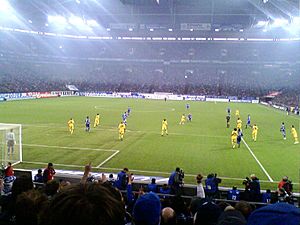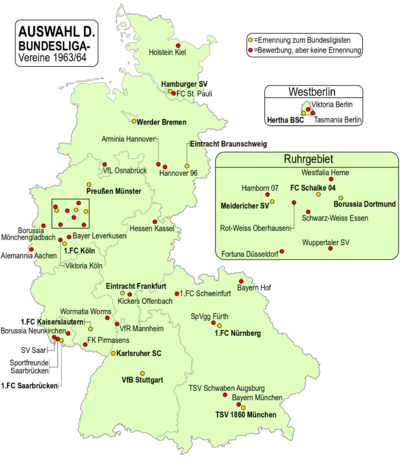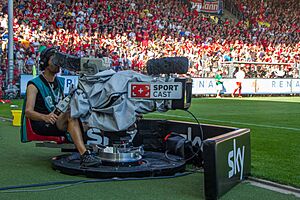Bundesliga facts for kids
 |
|
| Organising body | Deutsche Fußball Liga (DFL) |
|---|---|
| Founded | 24 August 1963 |
| Country | Germany |
| Confederation | UEFA |
| Number of teams | 18 (since 1992–93) |
| Level on pyramid | 1 |
| Relegation to | 2. Bundesliga |
| Domestic cup(s) | |
| International cup(s) | |
| Current champions | Bayern Munich (33rd title) (2024–25) |
| Most championships | Bayern Munich (33 titles) |
| Most appearances | Charly Körbel (602) |
| Top goalscorer | Gerd Müller (365) |
| TV partners | List of broadcasters |
The Bundesliga is Germany's top professional association football league. It's often called the Fußball-Bundesliga or 1. Bundesliga. Eighteen teams compete in the league. Teams can move up to the Bundesliga or down to the 2. Bundesliga based on how well they play. This system is called promotion and relegation.
Bundesliga seasons usually run from August to May. Games are played on Fridays, Saturdays, and Sundays. All Bundesliga teams also play in the DFB-Pokal cup competition. The winner of the Bundesliga gets to play in the DFL-Supercup.
The Bundesliga started in 1962 in Dortmund. The first season was in 1963–64. The league was first run by the German Football Association, but now the Deutsche Fußball Liga (German Football League) manages it. Many clubs have played in the Bundesliga since it began. Bayern Munich is the most successful team. They have won 33 titles out of 62 seasons. This includes winning eleven times in a row from 2013 to 2023. Other famous champions include Borussia Dortmund, Hamburger SV, Werder Bremen, Borussia Mönchengladbach, and VfB Stuttgart.
The Bundesliga is one of the best football leagues in Europe. It is currently ranked fourth in Europe based on how German teams have performed in European competitions over the last five years. Bundesliga teams have won many international trophies. These include eight UEFA Champions League titles. The Bundesliga also has the second-highest average attendance for football games in the world. About 38,656 fans attend each game. Only the English Premier League has more.
Bayern Munich is the current champion. They won the 2024–25 Bundesliga title with two games left in the season.
Contents
How the Bundesliga Works
The Bundesliga has two main parts: the 1. Bundesliga and the 2. Bundesliga. The 1. Bundesliga is the top league. The 2. Bundesliga is the second level of German football. Both are professional leagues. Below these, there is the 3. Liga, which is also professional. However, it is run by the German Football Association, not the German Football League.
Below the 3. Liga, the leagues are organized by region. For example, the Regionalligen are split into North, Northeast, South, Southwest, and West. Below these are many other leagues, often called Oberligen. These represent different states or large areas. The league structure changes often. It usually depends on how many people play football in different parts of Germany. After German reunification in 1990, the East German leagues joined the West German system.
Every team in the 1. and 2. Bundesliga needs a special license to play. If they don't have one, they get moved down to a lower league. To get a license, teams must be financially stable. They also need to follow certain rules about how they are run.
Being in the top league, the 1. Bundesliga, has many advantages:
- Teams get a bigger share of money from TV broadcasts.
- More fans come to watch 1. Bundesliga games. The average attendance is much higher than in the 2. Bundesliga.
- More TV exposure and higher attendance help teams get better sponsorship deals.
- Teams earn a lot of money from TV, ticket sales, and sponsorships. This helps them buy and keep skilled players. It also helps them build great stadiums.
The 1. Bundesliga is very strong financially. The 2. Bundesliga is also becoming more stable. It has better organization and finances. The quality of play in both leagues is very high.
No club has played in the Bundesliga every season since it started. Hamburger SV was the last founding club to be relegated. That happened for the first time on May 12, 2018.
Since the 2008–09 season, the Bundesliga uses a specific system for teams moving up or down:
- The two teams at the very bottom of the Bundesliga automatically move down to the 2. Bundesliga.
- The two top teams from the 2. Bundesliga automatically move up to the Bundesliga.
- The team that finishes third from the bottom in the Bundesliga plays two games against the team that finishes third in the 2. Bundesliga. The winner of these two games gets the last spot in the Bundesliga for the next season.
The season starts in early August and ends in late May. There is a six-week break in winter, from mid-December to the end of January. Since the 2002-03 season, the defending champions play the first game on a Friday night. The champions have not lost these opening matches. They have won 16 out of 21 games up to the 2022-23 season.
Bundesliga History
Early Days of German Football
Before the Bundesliga began, German football was played by amateur teams. There were many smaller regional leagues. In 1949, players started to become semi-professional. Only five main regional leagues, called Oberligen, remained. The champions from these regions would play in a tournament to decide the national champion. The German Football Association (DFB) was founded in 1900. The first national champion was VfB Leipzig in 1903.
During the 1950s, many people wanted a single, top professional league for the whole country. One problem with the old system was that top teams from different regions rarely played each other. Also, the knockout tournament meant a less strong team could win by getting lucky. Another worry was that professional leagues in other countries were attracting Germany's best players. German teams were not doing well against professional teams from other countries. Sepp Herberger, the national team coach, strongly supported creating a central league. He wanted Germany to catch up with countries like Italy, Spain, and England.
Meanwhile, in East Germany, a separate league called the DDR-Oberliga was set up in 1950. It had 14 teams, and two teams would move down each season.
How the Bundesliga Started
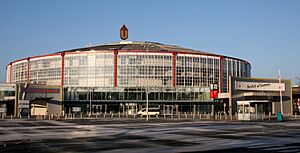
Germany's national team lost to Yugoslavia in the 1962 World Cup. This loss helped push for a national league. At the annual meeting of the German Football Association in Dortmund, the Bundesliga was officially created on July 28, 1962. It was set to start playing in the 1963–64 season.
At that time, West Germany had five main regional leagues. East Germany had its own separate league. Forty-six clubs wanted to join the new Bundesliga. Sixteen teams were chosen. They were picked based on their past success, financial health, and to make sure different regions were represented.
The first Bundesliga games were played on August 24, 1963. 1. FC Köln was the first Bundesliga champion.
German Reunification and Football
After German reunification in 1990, the East German football leagues joined the West German system. Two East German clubs, Dynamo Dresden and FC Hansa Rostock, joined the top-tier Bundesliga for the 1991–92 Bundesliga season. Other East German clubs joined lower leagues.
Bundesliga in the 21st Century
In the 2000s, the Bundesliga was known for being very competitive. Five different teams won the league title during that time. However, since 2013, Bayern Munich has been very dominant. They won the league every year from 2013 to 2023.
How the Competition Works
The German football champion is decided only by games played in the Bundesliga. Each team plays every other team twice: once at home and once away. This means there are 34 matchdays in a season.
Before the 1995–96 season, a win was worth two points. A draw was one point, and a loss was zero. Since then, a win is worth three points. A draw is still one point, and a loss is zero. The team with the most points at the end of the season wins the German championship.
Currently, the top four teams in the league automatically get to play in the UEFA Champions League. This is a big European competition. The two teams at the bottom of the Bundesliga table are moved down to the 2. Bundesliga. The two top teams from the 2. Bundesliga are moved up. The team that finishes 16th in the Bundesliga plays two games against the third-placed team from the 2. Bundesliga. The winner plays in the Bundesliga next season.
If teams have the same number of points, there are rules to decide who ranks higher:
- First, they look at the goal difference (goals scored minus goals against) for the whole season.
- Then, they look at the total goals scored for the whole season.
- Next, they check the results of games played between the tied teams.
- If still tied, they look at goals scored in games between the tied teams.
- Then, away goals scored in games between the tied teams.
- Finally, total away goals scored for the entire season.
If teams are still tied after all these rules, a special game would be played at a neutral location. But this has never happened in Bundesliga history!
For team selection, a team can have no more than five players from outside the European Union in their matchday squad. Teams can name nine substitute players, and five of them can enter the game.
Teams in the League
The number of teams in the Bundesliga has changed over time:
- 1963–64 to 1964–65: 16 teams
- 1965–66 to 1990–91: 18 teams
- 1991–92: 20 teams (when East German teams joined)
- Since 1992–93: 18 teams
Qualifying for European Competitions
German clubs can also play in big European competitions. The number of German clubs allowed depends on how well German clubs have performed in Europe over the past five years.
- UEFA Champions League: The teams finishing 1st, 2nd, 3rd, and 4th in the Bundesliga qualify for the group stage of the UEFA Champions League.
- UEFA Europa League: The team finishing 5th qualifies for the group stage of the UEFA Europa League.
- UEFA Europa Conference League: The team finishing 6th qualifies for the play-off round of the UEFA Europa Conference League.
- DFB-Pokal Winner: The winner of the German Cup (DFB-Pokal) also qualifies for the group stage of the Europa League. This happens no matter where they finish in the Bundesliga. If the Cup winner already qualified for the Champions League, their Europa League spot goes to the next highest-placed team in the Bundesliga that hasn't qualified for Europe.
Bundesliga Clubs
Here are the teams that are expected to play in the Bundesliga for the 2025–26 season:
| Club | Position in 2024–25 | First Bundesliga season | Number of seasons in Bundesliga | First season of current spell | Number of seasons of current spell | Bundesliga titles | National titles | Last title |
|---|---|---|---|---|---|---|---|---|
| FC Augsburgb | 12th | 2011–12 | 15 | 2011–12 | 15 | 0 | 0 | – |
| Bayer Leverkusenb | 2nd | 1979–80 | 47 | 1979–80 | 47 | 1 | 1 | 2024 |
| Bayern Munichb | 1st | 1965–66 | 61 | 1965–66 | 61 | 33 | 34 | 2025 |
| Borussia Dortmunda | 4th | 1963–64 | 59 | 1976–77 | 50 | 5 | 8 | 2012 |
| Borussia Mönchengladbach | 10th | 1965–66 | 58 | 2008–09 | 18 | 5 | 5 | 1977 |
| Eintracht Frankfurta | 3rd | 1963–64 | 57 | 2012–13 | 14 | 0 | 1 | 1959 |
| SC Freiburg | 5th | 1993–94 | 26 | 2016–17 | 10 | 0 | 0 | – |
| Hamburger SV | 2nd (2. B) | 1963–64 | 56 | 2025–26 | 1 | 3 | 6 | 1983 |
| 1. FC Heidenheimb | 16th | 2023–24 | 3 | 2023–24 | 3 | 0 | 0 | – |
| TSG Hoffenheimb | 15th | 2008–09 | 18 | 2008–09 | 18 | 0 | 0 | – |
| 1. FC Köln | 1st (2. B) | 1963–64 | 53 | 2025–26 | 1 | 1 | 1978 | |
| RB Leipzigb | 7th | 2016–17 | 10 | 2016–17 | 10 | 0 | 0 | – |
| Mainz 05 | 6th | 2004–05 | 20 | 2009–10 | 17 | 0 | 0 | – |
| FC St. Pauli | 14th | 1977–78 | 10 | 2024–25 | 2 | 0 | 0 | – |
| VfB Stuttgarta | 9th | 1963–64 | 59 | 2020–21 | 6 | 3 | 5 | 2007 |
| Union Berlinb | 13th | 2019–20 | 7 | 2019–20 | 7 | 0 | 0 | – |
| Werder Bremena | 8th | 1963–64 | 61 | 2022–23 | 4 | 4 | 4 | 2004 |
| VfL Wolfsburgb | 11th | 1997–98 | 29 | 1997–98 | 29 | 1 | 1 | 2009 |
b Never been relegated from the Bundesliga
Where are the Teams Located?
| Team | Location | Stadium | Capacity | R. |
|---|---|---|---|---|
| FC Augsburg | Augsburg | WWK Arena | 30,660 | |
| Union Berlin | Berlin | Stadion An der Alten Försterei | 22,012 | |
| Werder Bremen | Bremen | Weserstadion | 42,100 | |
| Borussia Dortmund | Dortmund | Signal Iduna Park | 81,365 | |
| Eintracht Frankfurt | Frankfurt | Deutsche Bank Park | 58,000 | |
| SC Freiburg | Freiburg im Breisgau | Europa-Park Stadion | 34,700 | |
| Hamburger SV | Hamburg | Volksparkstadion | 57,000 | |
| 1. FC Heidenheim | Heidenheim | Voith-Arena | 15,000 | |
| TSG Hoffenheim | Sinsheim | PreZero Arena | 30,150 | |
| 1. FC Köln | Cologne | RheinEnergieStadion | 49,698 | |
| RB Leipzig | Leipzig | Red Bull Arena | 47,800 | |
| Bayer Leverkusen | Leverkusen | BayArena | 30,210 | |
| Mainz 05 | Mainz | Mewa Arena | 33,305 | |
| Borussia Mönchengladbach | Mönchengladbach | Borussia-Park | 54,042 | |
| Bayern Munich | Munich | Allianz Arena | 75,000 | |
| FC St. Pauli | Hamburg | Millerntor-Stadion | 29,546 | |
| VfB Stuttgart | Stuttgart | MHPArena | 60,058 | |
| VfL Wolfsburg | Wolfsburg | Volkswagen Arena | 28,917 |
How Many Seasons Have Teams Played?
Fifty-eight teams have played in the Bundesliga since it started in the 1963–64 season. The teams listed in bold are currently in the Bundesliga. No team has played in every single season. Bayern Munich and Werder Bremen have played the most seasons, with 61 each.
- 61 seasons: Bayern Munich, Werder Bremen
- 59 seasons: Borussia Dortmund, VfB Stuttgart
- 58 seasons: Borussia Mönchengladbach
- 57 seasons: Eintracht Frankfurt
- 56 seasons: Hamburger SV
- 54 seasons: Schalke 04
- 53 seasons: 1. FC Köln
- 47 seasons: Bayer Leverkusen
- 44 seasons: 1. FC Kaiserslautern
- 40 seasons: Hertha BSC
- 38 seasons: VfL Bochum
- 33 seasons: 1. FC Nürnberg
- 30 seasons: Hannover 96
- 29 seasons: VfL Wolfsburg
- 28 seasons: MSV Duisburg
- 26 seasons: SC Freiburg
- 25 seasons: Fortuna Düsseldorf
- 24 seasons: Karlsruher SC
- 21 seasons: Eintracht Braunschweig
- 20 seasons: 1860 Munich, Mainz 05
- 19 seasons: Arminia Bielefeld
- 18 seasons: TSG Hoffenheim
- 15 seasons: FC Augsburg
- 14 seasons: KFC Uerdingen
- 12 seasons: Hansa Rostock
- 10 seasons: RB Leipzig, FC St. Pauli
- 7 seasons: Rot-Weiss Essen, Kickers Offenbach, Waldhof Mannheim, Union Berlin
- 6 seasons: Energie Cottbus
- 5 seasons: 1. FC Saarbrücken, Darmstadt 98
- 4 seasons: Rot-Weiß Oberhausen, SG Wattenscheid, Dynamo Dresden, Alemannia Aachen
- 3 seasons: Borussia Neunkirchen, Wuppertaler SV, FC 08 Homburg, 1. FC Heidenheim
- 2 seasons: Tennis Borussia Berlin, Stuttgarter Kickers, SpVgg Unterhaching, FC Ingolstadt, SC Paderborn, Greuther Fürth
- 1 season: Preußen Münster, Tasmania Berlin, Fortuna Köln, Blau-Weiß 90 Berlin, VfB Leipzig, SSV Ulm, Holstein Kiel
How the Bundesliga Makes Money
The Bundesliga is very successful financially. In the 2009–10 season, it earned €1.7 billion. This money came from game days, sponsorships, and TV rights. It was the only European football league where all clubs together made a profit that year. Bundesliga clubs spend less than half of their money on player wages. This is the lowest percentage among major European leagues.
The Bundesliga has the cheapest ticket prices and the highest average attendance among Europe's five biggest leagues. Bundesliga clubs often work closely with local companies. Many of these companies have grown into big global businesses. For example, Bayern Munich gets a lot of its money from company sponsorships.
Bundesliga clubs must be mostly owned by German club members. This is called the "50+1 rule." It stops one person or company from owning too much of a club. Clubs also have strict rules about using debt to buy things. A team only gets a license to play if it has strong finances. Because of these rules, many clubs were profitable even during tough times. In other big European leagues, many teams are owned by foreign billionaires and have a lot of debt.
There are a few exceptions to the 50+1 rule. Bayer Leverkusen, TSG 1899 Hoffenheim, and VfL Wolfsburg can be owned by corporations or investors. Bayer Leverkusen and Wolfsburg were started by big companies (Bayer AG and Volkswagen) for their employees. Hoffenheim has long been supported by SAP co-founder Dietmar Hopp.
Since 2000, the German Football Association and the Bundesliga have required every club to have a youth academy. These academies help develop young local players for the club and the national team. This has increased the number of young players in the Bundesliga. This also means clubs can spend more money on fewer, but very talented, players they buy.
Financial Rules
Bundesliga clubs have had financial rules for many years. These rules are similar to the UEFA Financial Fair Play Regulations. At the end of each season, clubs must apply for a license to play next year. The German Football Federation (DFB) checks all their financial records. They only give approval if the club is financially healthy. If clubs break the rules, they can get fines or lose points. If a club is losing money, it can only buy a new player if it sells another player for at least the same amount.
Also, no single person is allowed to own more than 49% of a Bundesliga club. The only exceptions are VfL Wolfsburg, Bayer Leverkusen, and FC Carl Zeiss Jena. These clubs were originally founded by factories.
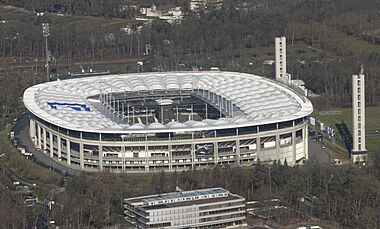
Even with good financial rules, some clubs have had problems. In 2004, Borussia Dortmund had a lot of debt. They had won the Champions League in 1997 and some Bundesliga titles. They spent a lot on expensive foreign players, hoping to keep winning. But they didn't, and almost went out of business in 2006. After that, the club changed a lot. They focused on young, home-grown players and became financially healthy again.
Fan Attendance

The Bundesliga is one of the most-attended football leagues in the world. In the 2024–25 season, about 38,656 fans attended each game on average. This makes it the second-highest attended football league globally. Borussia Dortmund holds the record for the highest average attendance of any football club in the world.
Compared to Europe's other big leagues, the Bundesliga has the lowest ticket prices and the highest average attendance. Many stadiums have large areas where fans can stand. Teams limit the number of season tickets. This makes sure that more people have a chance to see games live. The visiting team's fans also get 10% of the available seats. Match tickets often work as free train passes. This helps fans travel and enjoy the game.
Bundesliga chief executive Christian Seifert said that tickets are cheap because "It is not in the clubs' culture so much [to raise prices]. They are very fan orientated." Uli Hoeneß, president of Bayern Munich, once said, "We do not think the fans are like cows to be milked. Football has got to be for everybody."
Here are the attendance numbers for the Bundesliga over the last ten seasons:
| Season | Overall | Average | Best supported club | Average |
|---|---|---|---|---|
| 2011–12 | 13,805,514 | 45,116 | Borussia Dortmund | 80,521 |
| 2012–13 | 13,042,263 | 42,622 | 80,520 | |
| 2013–14 | 13,311,145 | 43,500 | 80,297 | |
| 2014–15 | 13,323,031 | 43,539 | 80,463 | |
| 2015–16 | 13,249,778 | 43,300 | 81,178 | |
| 2016–17 | 12,703,167 | 41,514 | 79,653 | |
| 2017–18 | 13,661,796 | 44,646 | 79,496 | |
| 2018–19 | 13,298,147 | 43,458 | 80,820 | |
| 2019–20 | 9,112,950 | 29,781 | Bayern Munich | 57,353 |
| 2020–21 | 163,705 | 535 | Borussia Dortmund | 1,282 |
| 2021–22 | 4,641,988 | 21,039 | 41,789 | |
| 2022–23 | 13,147,701 | 42,966 | 81,228 | |
| 2023–24 | 12,090,797 | 39,512 | 81,305 | |
| 2024–25 | 11,828,684 | 38,656 | 81,365 |
Watching the Bundesliga
In Germany
The DFL Sports Enterprises company handles the TV, radio, internet, and mobile rights for the Bundesliga. These rights are sold along with the rights for the relegation play-offs, 2. Bundesliga, and DFL-Supercup.
From 2017 to 2019, Bundesliga games were shown on TV in Germany on Sky Deutschland and Eurosport. Later, Eurosport's rights were taken over by the streaming service DAZN. A few Friday night matches are also shown on free TV channel Sat. 1.
Since the 2018–19 season, Sky has also arranged for some big Saturday games to be shown on free TV. This helps promote their coverage of the league. For example, the Revierderby (a big rivalry game) was shown on Das Erste in April 2019.
| Day | Time (CET) | Broadcaster |
|---|---|---|
| Friday | 20:30 | DAZN Sat.1 (1st, 17th, and 18th matchdays) (1 match) |
| Saturday | 15:30 | Sky Sport Bundesliga (5 matches) (4 matches in case of a third game on sunday) |
| 18:30 | Sky Sport Bundesliga (1 match) | |
| Sunday | 15:30 | DAZN (1 match) |
| 17:30 | ||
| 19:30 | DAZN (1 match on 5 matchdays) |
You can also listen to games on the radio. ARD stations offer "Konferenz" coverage, which switches between games. Local radio stations also provide full match coverage.
Around the World
The Bundesliga is broadcast on TV in more than 200 countries. In the United States, ESPN has held the rights since the 2020–21 season. Most games are on ESPN+, but some are on regular TV. In Canada, DAZN broadcasts the Bundesliga live.
In the United Kingdom and Ireland, you can watch the Bundesliga live on Sky Sports. In Spain, it's shown live on Movistar+.
In Indonesia, the Bundesliga is shown on MNC Group's TV channels and streaming services for the 2024–25 season. In Vietnam, it's on SKTV Life and other SKTV Sports channels. Taiwan's ELTA TV also started showing the Bundesliga again for the 2024–25 season. In 2015, StarTimes got the rights to show the Bundesliga in Sub-Saharan Africa for five years.
Bundesliga Champions
In total, 13 different clubs have won the Bundesliga title. This does not include older German championships or titles from the East German league. Bayern Munich holds the record with 33 titles.
List of Champions by Season
Who Has Won the Most Titles?
The table below shows how many Bundesliga titles each club has won. Clubs in bold are currently in the top division.
| Club | Winners | Runners-up | Winning seasons | Runners-up seasons |
|---|---|---|---|---|
| Bayern Munich | 33 | 10 | 1968–69, 1971–72, 1972–73, 1973–74, 1979–80, 1980–81, 1984–85, 1985–86, 1986–87, 1988–89, 1989–90, 1993–94, 1996–97, 1998–99, 1999–2000, 2000–01, 2002–03, 2004–05, 2005–06, 2007–08, 2009–10, 2012–13, 2013–14, 2014–15, 2015–16, 2016–17, 2017–18, 2018–19, 2019–20, 2020–21, 2021–22, 2022–23, 2024–25 | 1969–70, 1970–71, 1987–88, 1990–91, 1992–93, 1995–96, 1997–98, 2003–04, 2008–09, 2011–12 |
| Borussia Dortmund | 5 | 9 | 1994–95, 1995–96, 2001–02, 2010–11, 2011–12 | 1965–66, 1991–92, 2012–13, 2013–14, 2015–16, 2018–19, 2019–20, 2021–22, 2022–23 |
| Borussia Mönchengladbach | 5 | 2 | 1969–70, 1970–71, 1974–75, 1975–76, 1976–77 | 1973–74, 1977–78 |
| Werder Bremen | 4 | 7 | 1964–65, 1987–88, 1992–93, 2003–04 | 1967–68, 1982–83, 1984–85, 1985–86, 1994–95, 2005–06, 2007–08 |
| Hamburger SV | 3 | 5 | 1978–79, 1981–82, 1982–83 | 1975–76, 1979–80, 1980–81, 1983–84, 1986–87 |
| VfB Stuttgart | 3 | 3 | 1983–84, 1991–92, 2006–07 | 1978–79, 2002–03, 2023–24 |
| 1. FC Köln | 2 | 5 | 1963–64, 1977–78 | 1964–65, 1972–73, 1981–82, 1988–89, 1989–90 |
| 1. FC Kaiserslautern | 2 | 1 | 1990–91, 1997–98 | 1993–94 |
| Bayer Leverkusen | 1 | 6 | 2023–24 | 1996–97, 1998–99, 1999–2000, 2001–02, 2010–11, 2024–25 |
| 1860 Munich | 1 | 1 | 1965–66 | 1966–67 |
| VfL Wolfsburg | 1 | 1 | 2008–09 | 2014–15 |
| Eintracht Braunschweig | 1 | — | 1966–67 | |
| 1. FC Nürnberg | 1 | — | 1967–68 | |
| Schalke 04 | — | 7 | 1971–72, 1976–77, 2000–01, 2004–05, 2006–07, 2009–10, 2017–18 | |
| RB Leipzig | — | 2 | 2016–17, 2020–21 | |
| MSV Duisburg | — | 1 | 1963–64 | |
| Alemannia Aachen | — | 1 | 1968–69 | |
| Hertha BSC | — | 1 | 1974–75 |
Stars for Champions
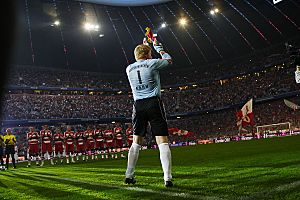
In 2004, a special honor was introduced for clubs that have won three or more Bundesliga championships since 1963. These clubs can display gold stars on their team badges and jerseys. The number of stars depends on how many titles they have won:
- 3 Bundesliga titles: 1 star
- 5 Bundesliga titles: 2 stars
- 10 Bundesliga titles: 3 stars
- 20 Bundesliga titles: 4 stars
- 30 Bundesliga titles: 5 stars
Some clubs, like BFC Dynamo from former East Germany, wanted their old league titles to count for stars. The German Football Association (DFB) decided in 2005 to allow all former German champions to display a single star with the total number of titles inside it. This includes titles from before the Bundesliga and from East Germany. However, this DFB rule only applies to teams playing below the top two divisions.
Since June 2010, the following clubs are officially allowed to wear stars while playing in the Bundesliga:




 Bayern Munich (33 titles)
Bayern Munich (33 titles)
 Borussia Dortmund (5 titles)
Borussia Dortmund (5 titles)
 Borussia Mönchengladbach (5 titles)
Borussia Mönchengladbach (5 titles) Werder Bremen (4 titles)
Werder Bremen (4 titles) Hamburger SV (3 titles)
Hamburger SV (3 titles) VfB Stuttgart (3 titles)
VfB Stuttgart (3 titles)
Bundesliga Records
Most Appearances
Here are the top ten players with the most games played in the Bundesliga:
| Rank | Player | Apps | Years | Club(s) |
|---|---|---|---|---|
| 1 | 602 | 1972–1991 | Eintracht Frankfurt 602 | |
| 2 | 581 | 1971–1991 | Hamburger SV 581 | |
| 3 | 557 | 1987–2008 | Karlsruher SC 128, Bayern Munich 429 | |
| 4 | 552 | 1965–1988 | Schalke 04 477, Werder Bremen 75 | |
| 5 | 546 | 1976–1996 | Borussia Dortmund 189, Werder Bremen 357 | |
| 6 | 535 | 1968–1988 | 1860 Munich 60, Schalke 04 295, 1. FC Köln 96, VfL Bochum 84 | |
| 7 | 534 | 1978–1995 | Borussia Dortmund 247, VfB Stuttgart 287 | |
| 8 | 523 | 2006– | Schalke 04 156, Bayern Munich 367 | |
| 9 | 520 | 1966–1983 | Borussia Dortmund 148, Werder Bremen 63, Wuppertaler SV 42, Eintracht Frankfurt 267 | |
| 10 | 518 | 1972–1988 | VfL Bochum 518 |
Boldface indicates a player still active in the Bundesliga.
Top Goal Scorers
Here are the top ten players who have scored the most goals in the Bundesliga:
| Rank | Player | Goals | Apps | Ratio | Years | Club(s) |
|---|---|---|---|---|---|---|
| 1 | 365 | 427 | 0.85 | 1965–1979 | Bayern 365/427 | |
| 2 | 312 | 384 | 0.82 | 2010–2022 | Dortmund 74/131, Bayern 238/253 | |
| 3 | 268 | 535 | 0.50 | 1968–1988 | 1860 Munich 28/60, Schalke 182/295, Köln 31/96, Bochum 27/84 | |
| 4 | 220 | 369 | 0.60 | 1965–1978 | M’gladbach 195/283, Hannover 25/86 | |
| 5 | 213 | 447 | 0.48 | 1969–1990 | Essen 32/74, Dortmund 135/224, Nürnberg 12/34, Bremen 34/115 | |
| 6 | 197 | 490 | 0.40 | 1999–2020 | Bremen 109/250, Bayern 87/224, Köln 1/16 | |
| 7 | 181 | 350 | 0.52 | 1990–2003 | Leverkusen 181/350 | |
| 8 | 179 | 449 | 0.40 | 1983–1999 | Bochum 47/120, Uerdingen 32/94, K'lautern 75/170, Bielefeld 25/65 | |
| 9 | 177 | 303 | 0.58 | 1973–1986 | Offenbach 0/2, Köln 159/248, Stuttgart 14/30, Saarbrücken 4/23 | |
| 177 | 424 | 0.42 | 1975–1993 | Düsseldorf 71/169, Köln 88/177, Bremen 18/78 |
See also
 In Spanish: Bundesliga (Alemania) para niños
In Spanish: Bundesliga (Alemania) para niños


